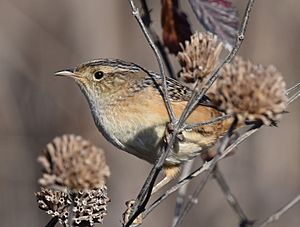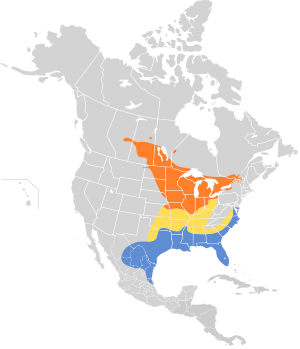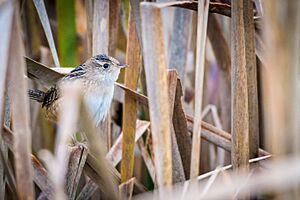Sedge wren facts for kids
Quick facts for kids Sedge wren |
|
|---|---|
 |
|
| In Prairie State Park, Missouri | |
| Conservation status | |
| Scientific classification | |
| Genus: |
Cistothorus
|
| Species: |
stellaris
|
 |
|
The sedge wren (Cistothorus stellaris) is a small, shy bird. It belongs to the wren family (Troglodytidae). These birds live across North America. You can often find them in wet grasslands and meadows. They build their nests in tall grasses and sedges. Sedge wrens mostly eat insects. This bird was once thought to be the same species as the grass wren from Central and South America. But scientists later found they are different.
Contents
About the Sedge Wren
The sedge wren was first described by a German scientist named Johann Friedrich Naumann in 1823. It used to be called the "short-billed marsh wren." However, its name was changed to "sedge wren." This helps people tell it apart from the similar marsh wren.
What Does a Sedge Wren Look Like?
The sedge wren is a small bird. It is about 10 to 12 centimeters (4 to 5 inches) long. It weighs about 7 to 10 grams (0.25 to 0.35 ounces). Its wingspan is about 12 to 14 centimeters (4.7 to 5.5 inches).
Male and female sedge wrens look very similar. Males are just a little bit bigger. Their head and back are brownish with black and white streaks. They have a light, creamy stripe above their eyes. Their eyes are brown. Their lower back is orange, and their tail is brownish with black bars. Their wings are also brownish with black, white, and light creamy bars. They have a white throat and belly. Their sides are light creamy.
Their beak is long and thin. The top part of the beak is brown, and the bottom part is yellow. Their legs and feet are pink. Young sedge wrens look like adults. But they have fewer streaks on their head and neck. Their chest is also lighter. You can tell a sedge wren from a marsh wren because it is smaller. It also has streaks on its head and a different song.
Where Sedge Wrens Live
Where They Are Found
During the time they raise their young, sedge wrens live in parts of Canada. This includes southern Alberta, Saskatchewan, Ontario, and Quebec. In the United States, they are found west of the Appalachian Mountains. They live from the Canadian border down to Missouri and northern Arkansas.
When it gets cold, they fly south for winter. They can be found from southern Arkansas down to Texas and Florida.
Their Home (Habitat)
When sedge wrens are raising their young, they usually live in meadows and wet grasslands. They can also live in wetter places like marshes. Sometimes, they even live in drier areas like prairies. They like places with thick, tall grasses and sedges. This is where they build their nests.
In winter, sedge wrens can be found in many different places. They just need enough insects to eat. For example, they might live in pine forests, dry prairies, meadows, marshes, or bogs.
Sedge Wren Behavior
How They Communicate (Vocalizations)
Sedge wren songs usually last about 1.5 to 2 seconds. They start with a few high notes or quick chirps. Then, they follow with a series of trills. Both males and females can make calls. But only the males sing.
Males sing from late winter to early spring in their winter homes. They also sing throughout the breeding season. They do this to attract mates. They sing both during the day and at night. Males usually sing to attract females. But they also "countersing." This is when one male sings, and another male answers with a different song. They often change their song types during this back-and-forth. Both males also sing faster when countersinging. Scientists think they do this to send as many signals as possible. This helps them communicate with other males or potential mates.
Making Up Their Songs
Sedge wrens make up their songs instead of learning them from other birds. Scientists have watched them in labs and in nature. They found that male wrens have many unique songs. Their songs are not very good copies of other wrens' songs. Also, very few males share the same songs.
This wide variety in songs happens because North American sedge wrens move around a lot. They are "nomadic breeders." This means they don't always return to the same place to breed each year. They breed where there are wet meadows and grasslands. If the conditions aren't right, they might not come back next year. Also, adult birds might move to wetter areas after raising their first group of babies. Because they move so much, different groups of wrens mix together. Birds rarely have the same neighbor twice. So, there is no need for them to perfectly copy their neighbors' songs. This leads to many different songs. Even though their songs vary a lot, wrens from all over North America can still understand each other.
What They Eat (Diet)
Sedge wrens look for food on the ground. They eat insects and spiders. They enjoy many types of insects. These include moths, flies, and grasshoppers.
How They Travel (Migration)
Sedge wrens are short-distance migrants. This means they don't fly extremely far. They also migrate at night. They leave their winter homes between early April and mid-May. They usually arrive at their breeding grounds between mid-April and mid-May.
They typically leave their breeding grounds when it gets too cold. Frost reduces the number of insects they can eat. They start leaving in August in the northern parts of their range. In central states, they might leave as late as the end of October. They begin to arrive in their winter homes starting in early September.
Breeding in Two Places?
Some scientists think that sedge wrens might migrate a second time during the breeding season. This would be to breed in a different location. Sedge wrens have been seen arriving and breeding in the Central Plains of the United States and Iowa in mid to late summer. They were not there earlier in the summer. However, we don't know for sure if these birds bred somewhere else before.
There are a few ideas about why this might happen. One idea is that these birds come from northern areas. Shorter summers there might stop them from having a second group of babies in the same place. Another idea is that these birds come from places where the environment changed. It might no longer be good for raising a second group of babies. A final idea is that males who couldn't find a mate in their first location move to the central plains. They then wait for other females who are also moving and try to breed with them.
Sedge Wren Life Cycle and Reproduction
Some male sedge wrens have one mate (monogamous). Others have several mates (polygynous). Males with multiple mates usually have more offspring. This means they have more baby birds.
Males arrive at breeding sites earlier than females. They set up their territories. Males who defend areas with more nesting spots and food usually attract more females. Males also build the nests. They build many nests. Some are for nesting, some are for sleeping, and some are to trick predators. The female then chooses a nest. She adds a soft lining of grass, sedge, and feathers.
The nests are round balls of dried grass. They have a round opening on the side. Nests are usually built in grasses and sedges. They are about one or two feet above the ground or shallow water. Females usually lay seven eggs. But they can lay anywhere from one to ten eggs. She sits on the eggs for 12 to 16 days. The eggs are oval-shaped and have no markings. They are about 16 by 12 millimeters (0.6 by 0.5 inches).
The baby birds are born helpless. They need their parents to feed and care for them. The females do most of the parenting and feeding. The males continue to build nests and try to attract other females. However, males will sometimes feed the young too. The young birds leave the nest after 11 to 16 days. Some females who breed early in the season can have a second group of babies later on.
See also
 In Spanish: Cucarachero culibarrado para niños
In Spanish: Cucarachero culibarrado para niños




